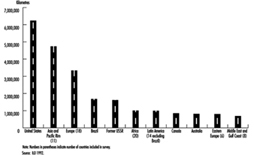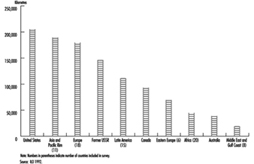The transport sector encompasses industries that are involved in the transportation of goods and passengers throughout the world. This sector is structurally complex and vitally important to economies locally, nationally and globally.
Economic Importance
The transport sector is vitally important to the economic viability of nations. Transportation plays a key role in economically important factors such as employment, utilization of raw and manufactured goods, investment of private and public capital and generation of tax revenues.
In most industrialized countries, transport accounts for 2 to 12% of the paid employment (ILO 1992). In the United States alone, the Department of Transportation reported that in 1993, there were approximately 7.8 million employees in trucking-related firms (DOT 1995). The transport sector’s share in the gross domestic product (GDP) and total employment tends to decrease as the country’s income increases.
The transport sector is also a major consumer of raw materials and finished goods in most industrialized countries. For example, in the United States, the transport sector utilizes approximately 71% of all rubber produced, 66% of all petroleum refined, 24% of all zinc, 23% of all cement, 23% of all steel, 11% of all copper and 16% of all aluminium (Sampson, Farris and Shrock 1990).
Capital investment utilizing public and private funds to purchase trucks, ships, airplanes, terminals and other equipment and facilities easily exceeds hundreds of billions of dollars in industrialized countries.
The transport sector also plays a major role in generating revenues in the form of taxes. In industrialized countries, transport of passengers and freight is often heavily taxed (Sampson, Farris and Shrock 1990; Gentry, Semeijn and Vellenga 1995). Typically these taxes take the form of fuel taxes on gasoline and diesel fuels, and excise taxes on freight bills and passenger tickets, and easily exceed hundreds of billions of dollars annually.
Evolution of the Sector
In the early stages of the transport sector, geography greatly influenced what was the dominant mode of transportation. As advances were made in construction technology, it became possible to overcome many of the geographical barriers that limited the development of the transport sector. As a result, the modes of transport that have dominated the sector evolved in accordance with the technology available.
Initially, water travel over the oceans was the primary mode of transport of freight and passengers. As large rivers were navigated and canals were built, the volume of inland transport over the waterways increased significantly. In the late nineteenth century, transport over railways began to emerge as the dominant mode of transport. Rail transport, because of its ability to overcome natural barriers such as mountains and valleys through the use of tunnels and bridges, offered flexibility that waterways could not provide. Furthermore, unlike transport over waterways, transport over the rails was virtually unaffected by winter conditions.
Many national governments recognized the strategic and economic advantages of rail transport. Consequently, rail companies were awarded governmental financial assistance to facilitate the expansion of rail networks.
In the early twentieth century, the development of the combustion engine combined with the increased use of motor vehicles enabled road transport to become an increasingly popular mode of transport. As the highway and throughway systems were developed, road transport enabled door-to-door deliveries of goods. This flexibility far surpassed that of railways and waterways. Eventually, as advances were made in road construction and improvements were made to the internal combustion engine, in many parts of the world road transport became faster than rail transport. Consequently, road transport has become the most used mode of transport of goods and passengers.
The transport sector continued to evolve with the advent of airplanes. The use of airplanes as a means to transport freight and passengers began during the Second World War. Initially, airplanes were primarily used to transport mail and soldiers. However, as aircraft construction was perfected and an increasing number of persons learned to operate airplanes, air transport grew in popularity. Today, air transport is a very fast, reliable mode of transport. However, in terms of total tonnage, air transport handles only a very small percentage of freight.
Structure of the Sector
Information on the structure of rail systems in industrialized countries is generally reliable and comparable (ILO 1992). Similar information on road systems is somewhat less reliable. Information on the structure of waterways is reliable, having not changed substantially in the past few decades. However, similar information regarding developing countries is scarce and unreliable.
European countries developed economic and political blocs that have had a significant impact on the transport sector. In Europe, road transport dominates the movement of freight and passengers. Trucking, with a heavy emphasis on less-than-trailer-load freight, is conducted by small national and regional carriers. This industry is heavily regulated and highly fractured. Since the early 1970s, the total volume of freight transported by road has increased by 240%. Conversely, rail transport has declined by approximately 8% (Violland 1996). However, several European countries are working diligently to increase the efficiency of rail transport and are promoting intermodal transport.
In the United States, the primary mode of transport is over the roadways. The Department of Transportation, Office of Motor Carriers, reported in 1993 that there were over 335,000 firms operating medium and heavy trucks (DOT 1995). This included large companies that transport their own products, smaller private firms, and for-hire truckload and less-than-truckload common and contract carriers. The majority of these fleets (58%) operate six or fewer trucks. These companies operate a total of 1.7 million combination units, 4.4 million single-unit medium and heavy trucks and 3.8 million trailers. The road system in the United States increased by roughly 2% from 1980 to 1989 (ILO 1992).
The rail systems in the United States have declined, due primarily to the loss of Class 1 status of some rail lines, and due to the abandonment of less profitable lines. Canada has increased its rail system by some 40%, due mainly to a change in the classification system. The road system in Canada has decreased by 9% (ILO 1992).
In the industrialized nations of the Pacific Rim, there is great variability of the rail and road systems, due mainly to the different levels of industrialization of the respective countries. For example, rail and road networks in the Republic of Korea are similar to those in Europe, whereas in Malaysia, the rail and road networks are significantly smaller, but experiencing tremendous growth rates (over 53% for roads since 1980) (ILO 1992).
In Japan, the transport sector is heavily dominated by road transport, which accounts for 90.5% of the total Japanese freight transport tonnage. Approximately 8.2% of the tonnage is transported by water and 1.2% by rail (Magnier 1996).
Developing countries in Asia, Africa and Latin America typically suffer from inadequate transport systems. There is significant work underway to improve the systems, but a lack of hard currency, skilled workers and equipment inhibits the growth. Transport systems have grown significantly in Venezuela, Mexico and Brazil.
The Middle East in general has experienced growth in the transport sector, with countries such as Kuwait and Iran leading the way. It should be noted that due to the large size of the countries, sparse populations and arid climatic conditions, unique problems are encountered that limit the development of transport systems in this region.
An overview of railroad and road systems for selected countries and world regions is shown in figure 1 and figure 2.
Figure 1. World road network distribution 1988-89, kilometers.
Figure 2. World railroad network distribution, 1988-89, in kilometers.
Workforce Characteristics
The transportation sector contributes significantly to employment in most countries in both the private and public sectors. However, as per capita income increases, the impact of the sector on total employment decreases. The overall number of workers in the transport industries has declined steadily since the 1980s. This loss of workforce in the sector is due to several factors, especially technological advances that have automated many of the jobs related to the construction, maintenance and operation of transport systems. In addition, many countries have passed legislation which deregulated many transport-related industries; this has ultimately resulted in the loss of jobs.
Workers who are currently employed in transport-related industries must be highly skilled and competent. Due to the rapid advances in technology experienced in the transport sector, these workers and prospective workers must receive continual training and retraining.


